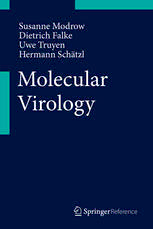
Molecular Virology PDF
Preview Molecular Virology
Susanne Modrow Dietrich Falke Uwe Truyen Hermann Schätzl Molecular Virology 1 3 Reference Molecular Virology Susanne Modrow (cid:129) Dietrich Falke € Uwe Truyen (cid:129) Hermann Schatzl Molecular Virology With164Figuresand86Tables SusanneModrow UweTruyen InstituteofMedicalMicrobiology InstituteforAnimalHygiene andHygiene andVeterinaryPublicHealth UniversityofRegensburg UniversityofLeipzig Regensburg,Germany Leipzig,Germany DietrichFalke HermannSch€atzl InstituteofVirology DepartmentofComparative JohannesGutenbergUniversity Biology&ExperimentalMedicine,Faculty Mainz,Germany ofVeterinaryMedicine,FacultyofMedicine UniversityofCalgary Calgary,Canada TranslationandCopyediting ArielQuin˜ones Halle,Germany Dr.StuartEvans WestRainton,UK ISBN978-3-642-20717-4 ISBN978-3-642-20718-1(eBook) ISBN978-3-642-20719-8(printandelectronicbundle) DOI10.1007/978-3-642-20718-1 SpringerHeidelbergNewYorkDordrechtLondon Thisworkisbasedonthe3rdGermanlanguageeditionofMolekulareVirologie,bySusanneModrow, DietrichFalke,UweTruyen,HermannSch€atzl,publishedbySpektrumAkademischerVerlag, Heidelberg2010. LibraryofCongressControlNumber:2013945856 #Springer-VerlagBerlinHeidelberg2013 Thisworkissubjecttocopyright.AllrightsarereservedbythePublisher,whetherthewholeorpartof the material is concerned, specifically the rights of translation, reprinting, reuse of illustrations, recitation,broadcasting,reproductiononmicrofilmsorinanyotherphysicalway,andtransmissionor informationstorageandretrieval,electronicadaptation,computersoftware,orbysimilarordissimilar methodologynowknownorhereafterdeveloped.Exemptedfromthislegalreservationarebriefexcerpts inconnectionwithreviewsorscholarlyanalysisormaterialsuppliedspecificallyforthepurposeofbeing enteredandexecutedonacomputersystem,forexclusiveusebythepurchaserofthework.Duplication ofthispublicationorpartsthereofispermittedonlyundertheprovisionsoftheCopyrightLawofthe Publisher’s location, in its current version, and permission for use must always be obtained from Springer.PermissionsforusemaybeobtainedthroughRightsLinkattheCopyrightClearanceCenter. ViolationsareliabletoprosecutionundertherespectiveCopyrightLaw. The use of general descriptive names, registered names, trademarks, service marks, etc. in this publicationdoesnotimply,evenintheabsenceofaspecificstatement,thatsuchnamesareexempt fromtherelevantprotectivelawsandregulationsandthereforefreeforgeneraluse. While the advice and information in this book are believed to be true and accurate at the date of publication,neithertheauthorsnortheeditorsnorthepublishercanacceptanylegalresponsibilityfor anyerrorsoromissionsthatmaybemade.Thepublishermakesnowarranty,expressorimplied,with respecttothematerialcontainedherein. Printedonacid-freepaper SpringerispartofSpringerScience+BusinessMedia(www.springer.com) Preface Today,knowledgeaboutvirusesordistinctaspectsofviralinfectionshasbecome important for our daily life. Continuously, we are confronted with headlines and newsconcerning,e.g.,newinfluenzaviruses,outbreaksofnorovirusepidemics,or transmission of otherwise rare zoonotic infections to humans. Due to the major progressinmolecularbiologyandbiotechnology,theknowledgeonviralinfections multiplied during the past decades. Thereby it is possible to characterize and identify new virus types rapidly after their first emergence. Rational development of both antiviral drugs and protective vaccines has reduced the potential danger emanatingfromvirusesforhumanandanimalhealth. Indeed,therearehardlyanyscientificdisciplinesthathavebenefitedfromeach other as much as molecular biology and virology. Several important processes in molecular biology and genetics have been initially discovered in viral systems as there is splicing of RNA precursors, nucleosomal structure of double-stranded DNA, or basic immunological defense reactions based on interferon-mediated effects. Additionally, the application of modern methods in molecular biology and biotechnology has led to an advanced knowledge and understanding of the processes involved in the infection caused by human and animal viruses. The Handbook of Molecular Virology tries to combine both disciplines to facilitate the understanding between the basic molecular process and the effects that are causedbytherespectivevirusinfectionsandmanifestedassymptomsordiseases. First published in Germany in 1996, the present volume represents the transla- tionofthethirdeditionofthetextbookMolekulareVirologie,whichappearedin print in 2010. In several places the text has been updated with recently published data.Themainfocusofallchaptersisonvirusinfections,theknowledgeofwhich is important for human and animal health. The content is divided into two parts: Chapters1–13addressgeneralaspectsofvirusreplication,structure,andimmuno- logical defense. In chapters 14–21, the molecular biology of each virus family is described in detail along with clinical and epidemiological data for the relevant viralinfections.PrimarilywrittenforreadersinCentralEurope,theGermanedition had a special focus on viral infections with relevance for the German-speaking countries.IntheEnglishedition,wehavetriedtoadaptthetextanddeleteddetails thatdescribetheepidemiologyandrequirementsofnotificationinCentralEurope. Forreadersthatareinterestedinthosedatawe haveincludedalistofwebsitesof v vi Preface various national and international public health organizations that provide the respectiveinformation. WethankallthecoworkersfromSpringer,Heidelberg,thathavecontributedto the English edition as translators and copyeditors (Ariel Quin˜ones, Dr. Stuart Evans), and project managers (Daniel Quin˜ones, Dr. Sylvia Blago) who patiently answered all our questions. Furthermore, we are indebted to all our colleagues in virologywhowepesteredwithspecificquestionsinordertoobtainthemostrecent data and results. Dr. Hans Gelderblom supplied almost all the figures that show selected electron microscopic pictures of representative members of each virus family in combination with a chapter describing the basic methods in electron microscopy. Last but not least, we thank all our family members, friends and colleagues, who share our daily lives and who we had to neglect during the writing/translationprocess. July2013 SusanneModrow,Regensburg DietrichFalke,Mainz UweTruyen,Leipzig HermannSch€atzl,Calgary Contents PartI ................................................. 1 1 HistoricalOverview .................................... 3 2 Viruses:Definition,Structure,Classification ................. 17 3 ViralProliferationandReplication ........................ 31 4 Pathogenesis .......................................... 39 5 CellDamage .......................................... 49 6 TransformationandCarcinogenesis ....................... 57 7 Immunology .......................................... 69 8 Cytokines,ChemokinesandInterferons .................... 95 9 Chemotherapy ......................................... 115 10 Vaccines ............................................. 135 11 Epidemiology ......................................... 147 12 ViralEvolution ........................................ 155 13 LaboratoryMethodsforDetectingViralInfections ........... 163 PartII ................................................ 183 14 ViruseswithSingle-Stranded,Positive-SenseRNAGenomes .... 185 15 ViruseswithSingle-Stranded,Non-Segmented,Negative-Sense RNAGenomes ......................................... 351 16 ViruseswithSingle-Stranded,Segmented,Negative-Sense RNAGenomes ......................................... 437 17 ViruseswithDouble-Stranded,SegmentedRNAGenomes ...... 521 vii viii Contents 18 ViruseswithSingle-StrandedRNAGenomesand Double-StrandedDNAasanIntermediateProduct ........... 555 19 ViruseswithaDouble-StrandedDNAGenome ............... 625 20 ViruseswithaSingle-StrandedDNAGenome ................ 875 21 Prions ............................................... 919 Appendix1–TransmissionElectronMicroscopyinVirology: Principles,PreparationMethodsandRapidDiagnosis ......... 949 Appendix2–Informationonthe“Prototypical Electron-MicroscopicPortraits”ofIndividualVirusFamilies .... 955 Glossary ............................................. 961 AdditionalInformation .................................. 975 Index ................................................ 979 Part I
